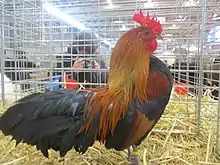Ardennaise
The Ardennaise, French: Poule ardennaise, is a breed of domestic chicken from the Ardennes plateau, in Belgium and eastern France.[6] Its range extends from the Pays de Herve in Wallonia to the French département of Ardennes, and includes the Fagnes, the Famenne, and the valleys of the Amblève, the Ourthe and the Semois.[7]
 Bantam cock at the Salon international de l'agriculture in Paris, 2018 | |
| Conservation status | FAO (2007): endangered[1] |
|---|---|
| Other names | |
| Country of origin | Belgium France |
| Distribution | Ardennes |
| Use | dual-purpose, eggs and meat |
| Traits | |
| Weight | |
| Comb type | single comb |
| Classification | |
| APA | not listed[3] |
| EE | yes[4] |
| PCGB | not listed[5] |
| |

History
The Ardennaise is a traditional breed of the Ardennes region. The first description is that of Victor La Perre de Roo in 1882,[8] at a time when the breed was already becoming rarer. A poultry breeders' club, the Union Avicole de Liége, was formed in 1893, and under its protection the Ardennaise enjoyed almost thirty years of success. Following the First World War, mass importations of yellow-legged birds from Italy, with much higher laying abilities, were a new threat. Selective breeding of the Ardennaise for better laying ability began in 1922, with some success. However, the Ardennaise was also cross-bred with Leghorn stock, resulting in a further decline. By 1940 there was no remaining trace of the breed. It was reconstituted over a period of about thirty years after the Second World War. In 2009 the total population was estimated at well over 2000.[7]
A bantam Ardennaise was created in Liège in the space of five or six years from 1904. It was shown from 1907, and the standard was approved in 1913.[7]
A tail-less variant, sometimes treated as a separate breed,[9] the Dutch: Ardenner Bolstaart or French: Sans-queue des Ardennes, is identical to the standard breed in all respects, except for the absence of the coccygeal bone and the tail, caused by the dominant Rp gene. Both the Sans-queue and its tail-less bantam variant are critically endangered.
Characteristics
The Ardennaise is genetically close to the Bresse Gauloise.[7] Twelve colours are recognised.[4]
Use
In a year an Ardennaise hen lays approximately 180 white eggs weighing 36–57 g (1.3–2.0 oz), with an average weight of 52 g (1.8 oz).[7]
References
- Barbara Rischkowsky, D. Pilling (eds.) (2007). List of breeds documented in the Global Databank for Animal Genetic Resources, annex to The State of the World's Animal Genetic Resources for Food and Agriculture. Rome: Food and Agriculture Organization of the United Nations. ISBN 9789251057629. Archived 23 June 2020.
- Alain Fournier (2005). L'élevage des poules. Paris: Artémis. ISBN 9782844163509.
- APA Recognized Breeds and Varieties: As of January 1, 2012. American Poultry Association. Archived 4 November 2017.
- Liste des races et variétés homologuée dans les pays EE (28.04.2013). Entente Européenne d’Aviculture et de Cuniculture. Archived 16 June 2013.
- Breed Classification. Poultry Club of Great Britain. Archived 12 June 2018.
- Breed data sheet: Ardennaise/Belgium. Domestic Animal Diversity Information System of the Food and Agriculture Organization of the United Nations. Accessed October 2014.
- N. Moula, M. Jacquet, A. Verelst, N. Antoine-Moussiaux, F. Farnir, P. Leroy (2012). Les races de poules belges (in French). Annales de Médecine Vétérinaire 156: 37-65. Accessed October 2014.
- Victor La Perre de Roo (1882). Monographie des races de poules (in French). p. 162–64.
- Breed data sheet: Ardenner bolstaart/Belgium. Domestic Animal Diversity Information System of the Food and Agriculture Organization of the United Nations. Accessed October 2014.